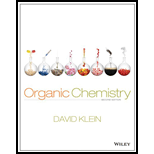
(a)
Interpretation:
The most stable E1 product for each of the given reactions is needed to be drawn.
Concept introduction:
In an elimination reaction,
E1 reaction is a unimolecular elimination reaction in which carbocation is formed as an intermediate and it has stepwise mechanism.
The product of the E1 elimination reaction is depends upon the two β-positions of alkyl halide. If the β-positions are identical and the products formed are also identical. If the β-positions are different and the products formed are also different. This means the double bond can form in two different regions so this type of reaction is called regioselective.
The bulkiness of the base controls the regioselectivity in an elimination reaction. The sterically hindered bases form less substituted alkene and non-sterically hindered bases form more substituted alkenes.
To draw: the major E1 product for the given reactions.
(b)
Interpretation:
The most stable E1 product for each of the given reactions is needed to be drawn.
Concept introduction:
In an elimination reaction, alkenes are formed when alkyl halides are treated with bases via eliminating one proton and one halo group of the alkyl halide.
E1 reaction is a unimolecular elimination reaction in which carbocation is formed as an intermediate and it has stepwise mechanism.
The product of the E1 elimination reaction is depends upon the two β-positions of alkyl halide. If the β-positions are identical and the products formed are also identical. If the β-positions are different and the products formed are also different. This means the double bond can form in two different regions so this type of reaction is called regioselective.
The bulkiness of the base controls the regioselectivity in an elimination reaction. The sterically hindered bases form less substituted alkene and non-sterically hindered bases form more substituted alkenes.
To draw: the major E1 product for the given reactions.
Want to see the full answer?
Check out a sample textbook solution
Chapter 8 Solutions
Organic Chemistry
 ChemistryChemistryISBN:9781305957404Author:Steven S. Zumdahl, Susan A. Zumdahl, Donald J. DeCostePublisher:Cengage Learning
ChemistryChemistryISBN:9781305957404Author:Steven S. Zumdahl, Susan A. Zumdahl, Donald J. DeCostePublisher:Cengage Learning ChemistryChemistryISBN:9781259911156Author:Raymond Chang Dr., Jason Overby ProfessorPublisher:McGraw-Hill Education
ChemistryChemistryISBN:9781259911156Author:Raymond Chang Dr., Jason Overby ProfessorPublisher:McGraw-Hill Education Principles of Instrumental AnalysisChemistryISBN:9781305577213Author:Douglas A. Skoog, F. James Holler, Stanley R. CrouchPublisher:Cengage Learning
Principles of Instrumental AnalysisChemistryISBN:9781305577213Author:Douglas A. Skoog, F. James Holler, Stanley R. CrouchPublisher:Cengage Learning Organic ChemistryChemistryISBN:9780078021558Author:Janice Gorzynski Smith Dr.Publisher:McGraw-Hill Education
Organic ChemistryChemistryISBN:9780078021558Author:Janice Gorzynski Smith Dr.Publisher:McGraw-Hill Education Chemistry: Principles and ReactionsChemistryISBN:9781305079373Author:William L. Masterton, Cecile N. HurleyPublisher:Cengage Learning
Chemistry: Principles and ReactionsChemistryISBN:9781305079373Author:William L. Masterton, Cecile N. HurleyPublisher:Cengage Learning Elementary Principles of Chemical Processes, Bind...ChemistryISBN:9781118431221Author:Richard M. Felder, Ronald W. Rousseau, Lisa G. BullardPublisher:WILEY
Elementary Principles of Chemical Processes, Bind...ChemistryISBN:9781118431221Author:Richard M. Felder, Ronald W. Rousseau, Lisa G. BullardPublisher:WILEY





